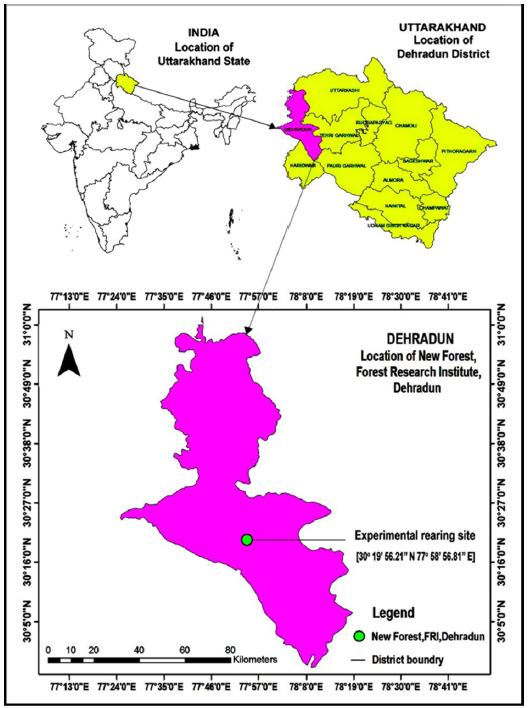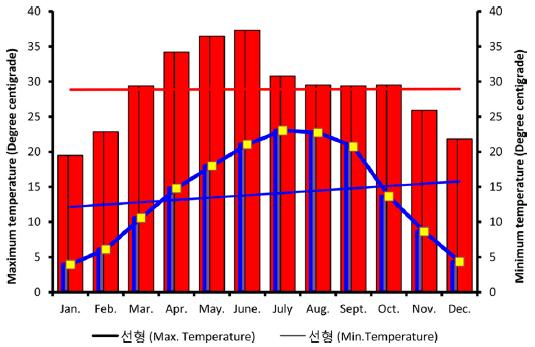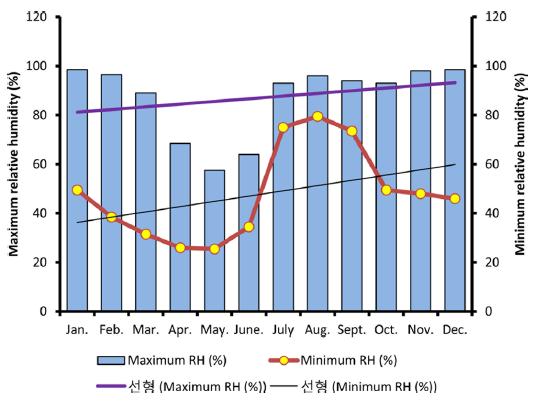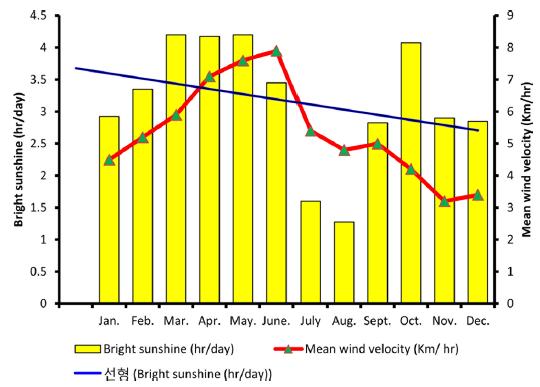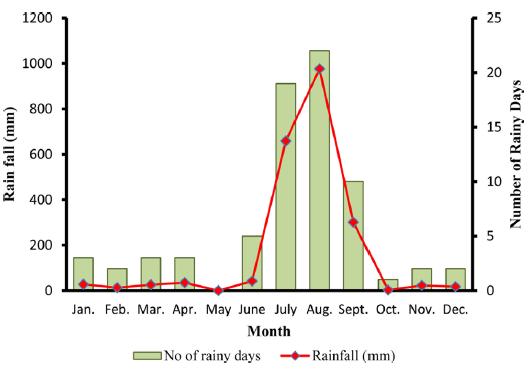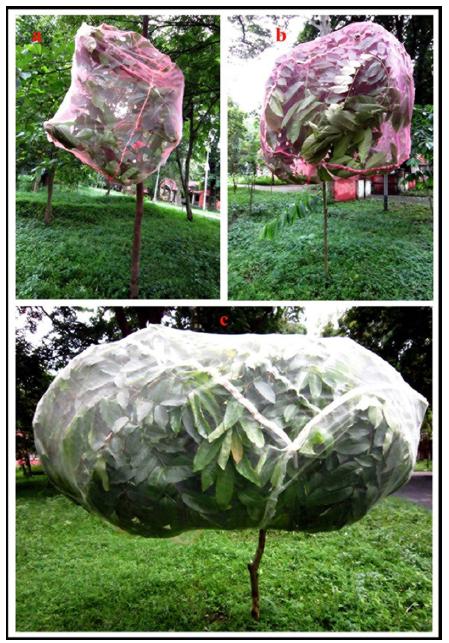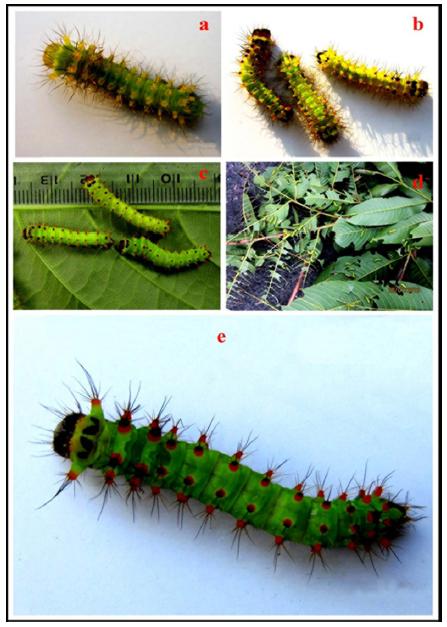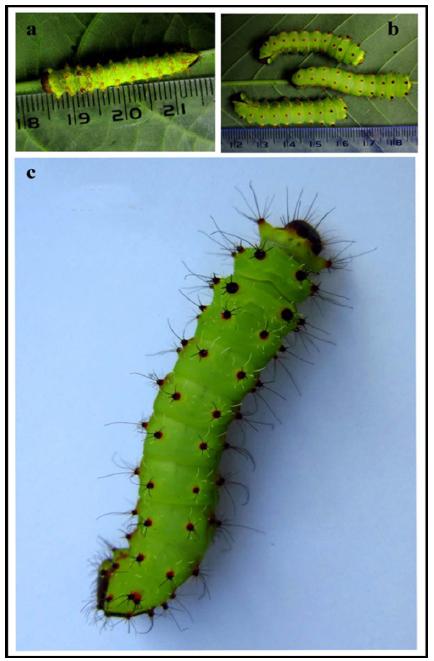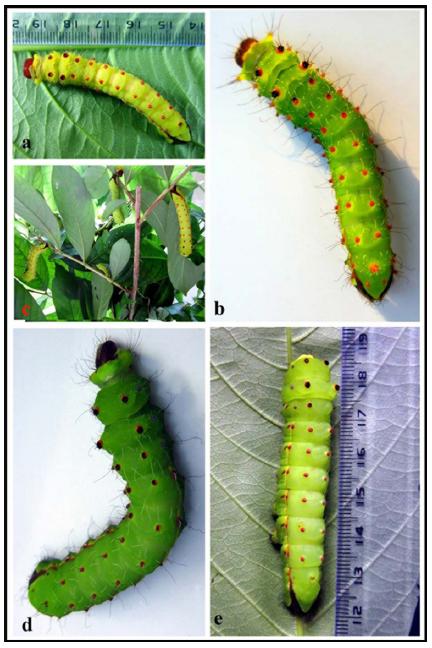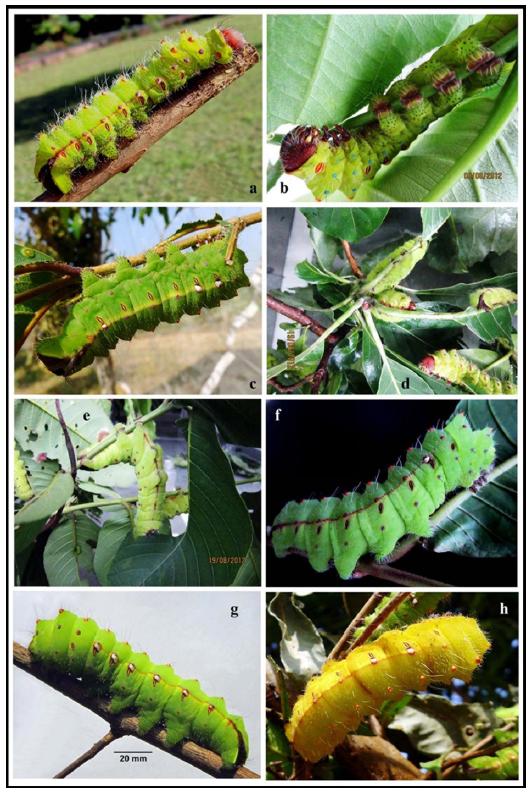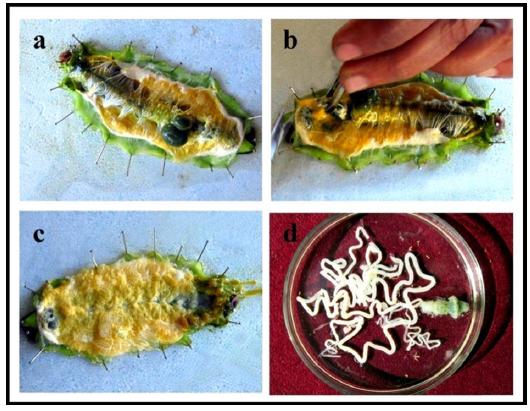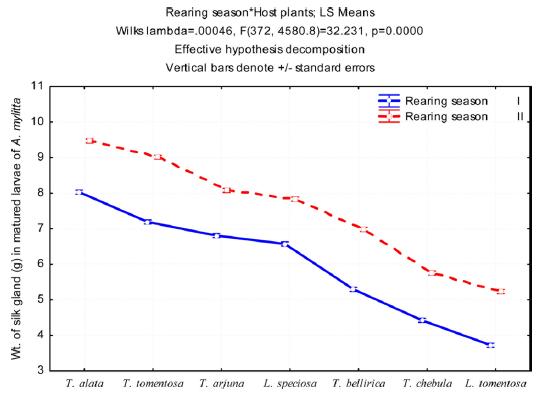



Forestry host plants differ greatly with their nutrient profile (Kohli
Studies have proven the significance of seasonal variations on biology and development of insects (Odum, 1983; Ouedraogo
In commercial tasar silkworm rearing, larvae should be healthy and their silk glands should be free from any abnormalities to reduce presence of non-spinning silkworms to zero. In the present work, expression of silk gland weight by
The study was conducted at New Forest, Forest Research Institute (FRI), Dehra Dun, Uttarakhand, which is situated at 30° 19’ 56.21’’ N to 30° 21’ 5.35’’ N and 77° 58’ 56.81’’ E to 78° 0’ 59.73’’ E at 640.08 AMSL (Fig. 1). The climate of New forest, Dehra Dun is moderate due to its location at foot of the Himalayas (WMD, 2011) and is monsoon-dominated like Gangetic Indian Plain. In the foothills, altitude is the main factor for variation in temperature and vegetation. The climatic variables of the study site is summarised in Fig 2, 3, 4, & 5 and the normal climatic data of Doon Valley for last thirty years is shown in table 1.
[Table 1.] Normal weather data* of New forest, FRI, Dehra Dun
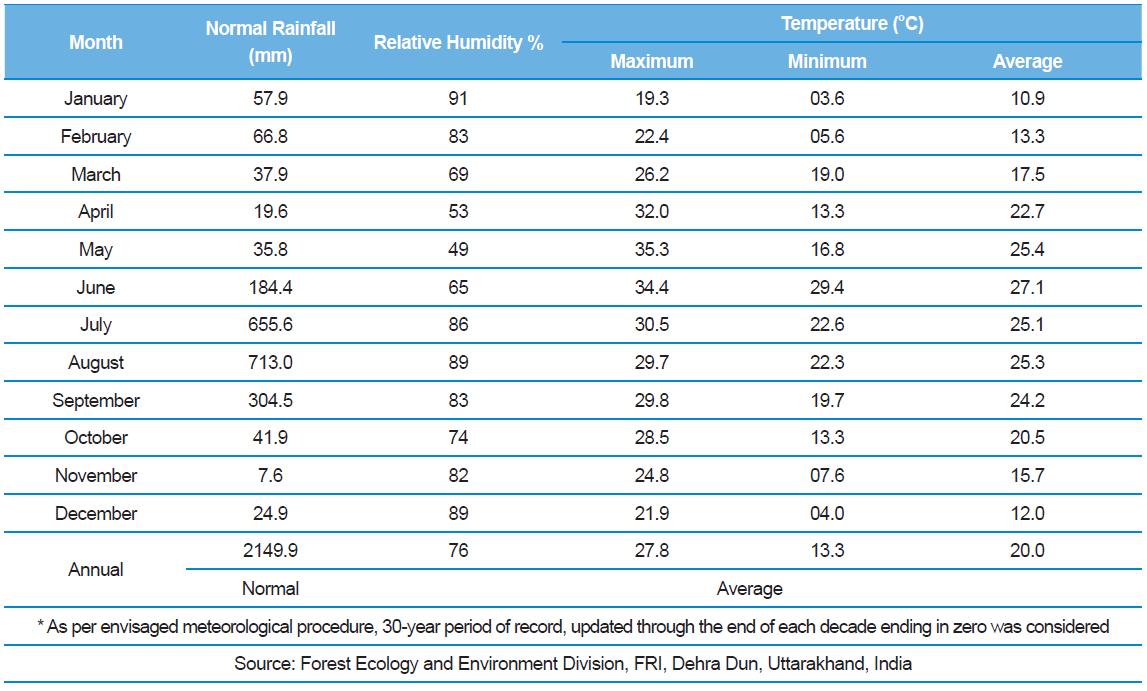
Normal weather data* of New forest, FRI, Dehra Dun
>
Forest tree species and out door rearing of A. mylitta
Outdoor tasar silkworm rearing was conducted on 5-6 year old bushes of seven forest tree species viz.,
>
Silk gland weight of matured larvae
The silkworm larvae, grown on different forestry host plants were collected one day before to the spinning. The individual larvae were dissected for silk glands (Fig. 11). The dissected silk glands were allowed for 5-7 min in the buffer and later transferred to thin and neat blotting paper to dry the excess moisture on the surface of gland and immediately thereafter, weight of the silk glands was recorded. The silk glands are the most conspicuous part of the larval anatomy. Morphologically, the silk gland is divided into two distinct regions. The narrow proximal region is the excretory duct, whereas the thick, long and highly convoluted distal region is secretary region.
>
Statistical methods and analysis of Data
Tested forest tree species were taken as treatments, so there were 07 treatments, and the number of replications were 06. Normality of data was checked before to the statistical analysis. Descriptive statistics were calculated by using Microsoft Excel. Data of first and second rearing seasons were combined together, then treatment wise descriptive statistics were calculated and mean tables were prepared. A two-way completely randomized block factorial design was used to test the significance of difference in the means of variable. We did Factorial ANOVA by using advance statistical software, STATISTICA 10. Rearing season, host plant and their interactions were treated as the main (fixed) effects and silk gland weight served as dependent variables for block effect. The level of significance was fixed at
As forest based commercial rearing of
Evaluation Index (E.I.) shows an aggregate unit of cocoon yield of
>
Multiple regressions studies on different traits of A. mylitta
We carried out multiple regression analysis for dependent variable of weight of silk gland in matured larvae of
Table 2 reveals that null hypothesis (H0) for no difference on effect of rearing seasons, host plants and their interactions on mean weight of silk gland in mature larvae of

Analysis of variance for the effect of rearing seasons, host plants and their interactions on weight of silk gland (g) in mature larvae of A. mylitta
Fig. 12 indicates that silk gland weight in matured larvae of
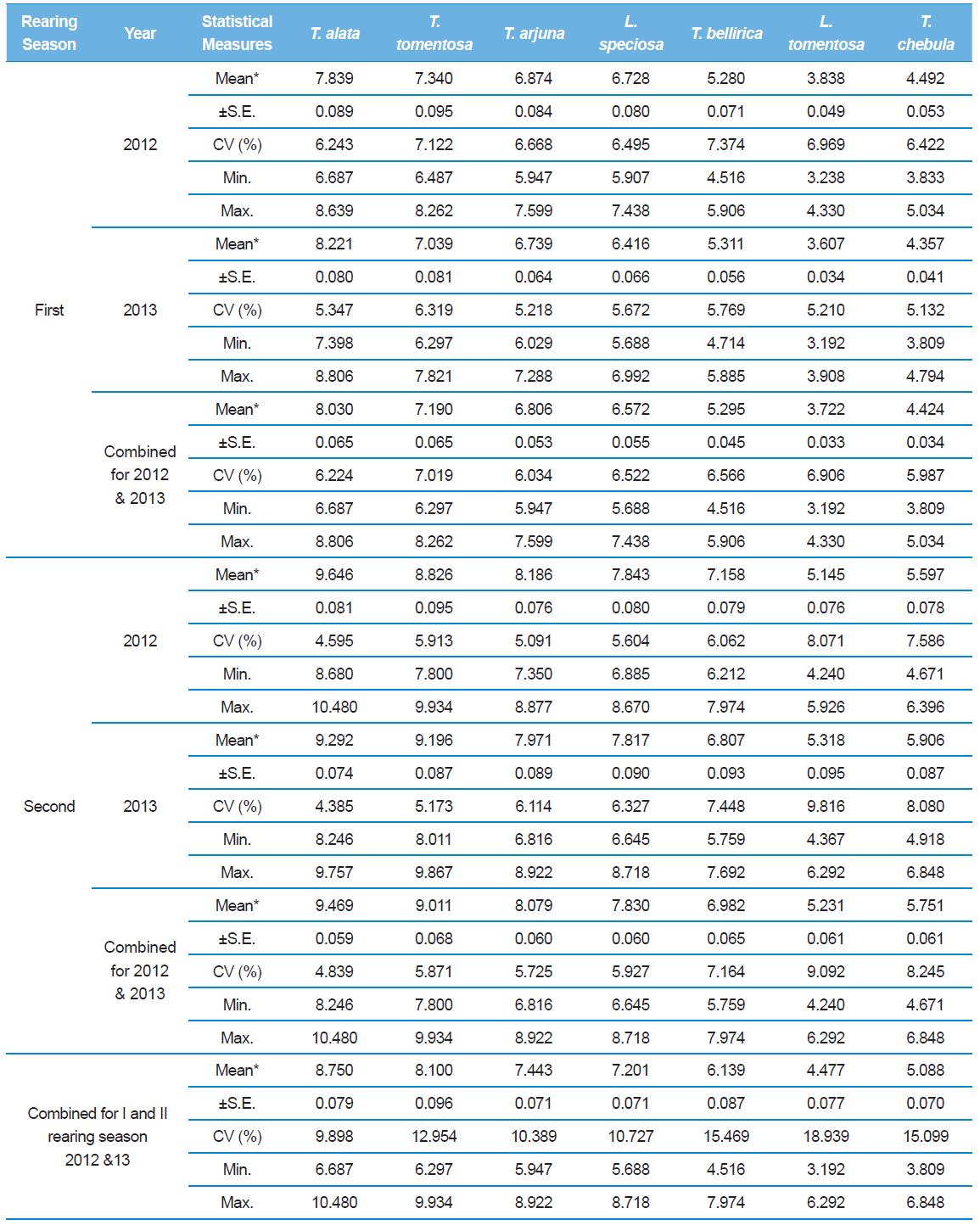
Effect of rearing seasons and host plants on weight of silk gland (g) in matured larvae of A. mylitta, reared on different host plants
Results of Tukey HSD test in table 4 indicates that weight of silk gland differed significantly between rearing seasons and formed two homogeneous groups. Table 5 on Tukey HSD test for the effect of host plants on silk gland weight indicated seven homogeneous groups of means that differed significantly from one another.
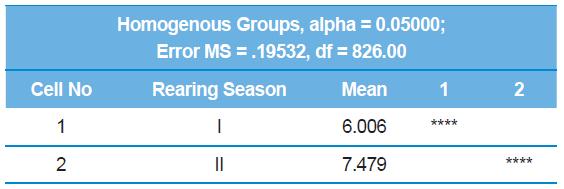
Tukey HSD test for the effect of rearing seasons on weight of silk gland (g) in matured larvae of A. mylitta, reared on different host plants

Tukey HSD test for the effect of host plants on weight of silk gland (g) in matured larvae of A. mylitta, reared on different host plants
Further, Tukey HSD test for the effect of interactions between rearing seasons and host plants (table 6) indicated ten homogeneous groups of means that differed significantly from one another. Table also showed that silk gland weight of
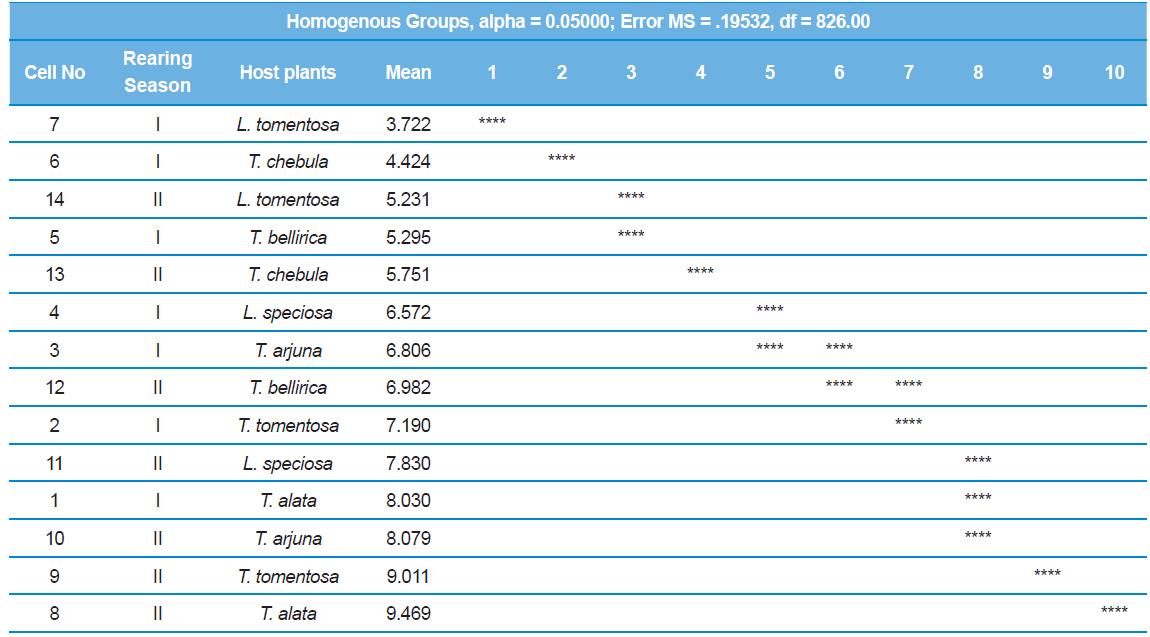
Tukey HSD test for the effect of interactions between rearing seasons & host plants on weight of silk gland (g) in matured larvae of A. mylitta
Weight of silk gland is a desirable character; therefore, a higher value of E.I. is required. Table 7 indicates that four forestry host plants viz.,

Evaluation Index (E.I.) for the weight of silk gland (g) in matured larvae of A. mylitta, reared on different host plants
Multiple regression analysis for dependent variable of mean weight of silk gland in matured larvae of

Multiple regression summary for dependent variable ? weight of silk gland in matured larvae of A. mylitta
However, larval duration from first to fifth instar showed significant negative regression weight (β=-0.270, t=-8.436,
It was found that seasons, host plants and their interaction affected the weight of silk gland significantly (
It was further found that
Banagade and Tembhare (2002) studied the effect of some exogenous factors such as photoperiod, starvation, food plants, and supplementary food on silk gland protein in
Rajesh Kumar and Elangovan (2010) had also found significant variations in the silk gland weight of eri silkworm reared on different food plants. Results of present study are also supported by the findings of Lokesh
Results of multiple regression analysis indicated that the larval weight gain had significant positive regression on mean weight of silk gland. It indicates that with increase in larval weight gain, a simultaneous increase can be expected in the weight of silk gland. Regression equation indicates that larval weight gain is a strong predictor for corresponding silk gland weight of
Our results confirmed that for achieving higher weight of larval silk gland weight of

